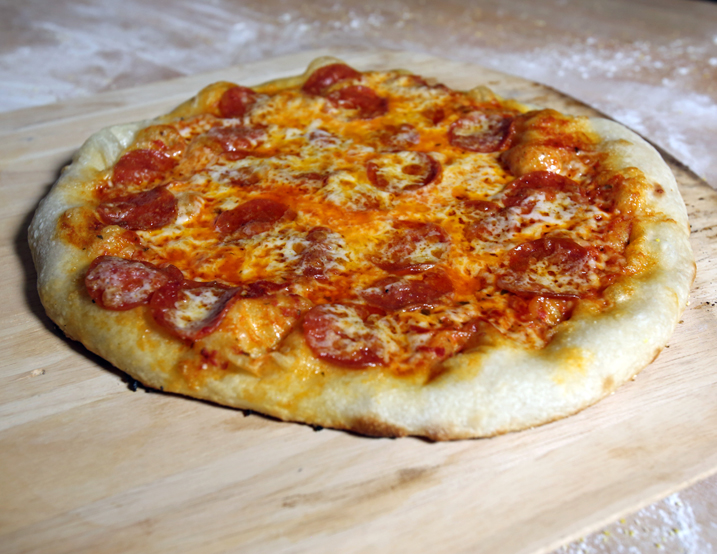
My Favorite Pizza

ACTIVE TIME: 30 minutes
TOTAL TIME: 2 days 12 hours 40 minutes
Of the myriad of pizza styles out there in the world (and I love them all), the style known as Neapolitan is my favorite. Neapolitan pies tend to be simply and elegantly dressed, and always built upon a crisp crust, often as thin as a communion wafer.Of course, I wouldn't dare refer to the pizza produced by the following recipe as a Neapolitan pizza because I don't wish to run afoul of pizza purists who would rightfully point out that American home ovens are incapable of cranking out the 800℉ minimum required to produce an even halfway respectable Neapolitan pizza. Such mavens might even slap calipers on my cornicione and proclaim your truly a cafone. I just don't need the hassle. So, let's just say this is my home-oven-homage to a Neapolitan pizza.A few things to note, especially if you've followed any of my recipes for pizzas past:-This dough calls for 00 or "double 0" flour a very fine, durum wheat flour, commonly used in Italy, and specifically in the pizzerias of Naples, though American companies are now making their own versions. (We ran tests with multiple brands and the 00 from King Arthur Baking Company produced the favorite results.) Depending on the formulation, "00" flours typically contain anywhere form 10% to 12% protein, a bit less than the 12% to 14% found in most bread flours.-Due to their extremely fine grind, 00 flours absorb water more rapidly than most all purpose or bread flours. This means we can go with a hydration rate of 60% (the total weight of the water divided by that of the total flour), which translates to a less-sticky dough that's easier to work with. Another characteristic of 00 flour doughs is that they tend to be less elastic than doughs made from bread flours, which means they're easier to shape.-Unlike most of my pizza recipes, which call for transferring from a peel to a baking stone, I prefer an uncoated, perforated aluminum pizza pan here which opens up several options for aging the dough after it's rolled. My favorites were made by Rema, and though I don't think they're made anymore, just about any 16" aluminum pan with lots of little holes in it will do, as long as you skip any non-stick coating.-I use a French-style rolling pin for this dough, to get the rounds as thin as possible, and also to work out any yeast-blown bubbles that could become mega-blisters in the oven. French rolling pins are solid cylinders of wood which slightly taper at the ends. If you're only going to own one rolling pin, I suggest you make this the one.-This dough comes into its own via a long, cool rise. I tend to make it at night so that I can guarantee it 18-24 hours in the refrigerator.Makes two 300 gram doughs for two 14" pizzas. )To finish a pie with my favorite ingredients, keep reading.)Photo by Lynne Calamia
Read More
Read Less
Software
- 3 cups 00 pizza flour (13 ounces)
- 2 teaspoons active dry yeast
- 1 teaspoon sugar
- 1 1/2 teaspoons kosher salt
- 1 cup filtered water, 110-120℉ (8 ounces)
- 1 tablespoon extra-virgin olive oil
- 1 tablespoon fine cornmeal (for dusting the pizza pan)
Additional software for dressing 1 pizza:
- 2 medium tomatoes, sliced 1/4-inch thick
- 1 1/2 teaspoons kosher salt
- 1 1/2 teaspoons freshly ground black pepper
- 1 1/2 teaspoons dried oregano, divided
- 1 1/2 teaspoons dried basil, divided
- 1 teaspoon dried thyme
- 1 tablespoon extra-virgin olive oil
- 1 1/2 ounces grated parmesan cheese, divided
- 1 1/2 teaspoons
gochugaru (Korean chili flakes) or, 1 teaspoonUrfa biber , orAleppo pepper - 4 ounces shredded mozzarella cheese
Specialized Hardware
stand mixer with dough hook
French rolling pin
Perforated round pizza pan in the 14"-16" range
Pastry brush

ACTIVE TIME: 30 minutes
TOTAL TIME: 2 days 12 hours 40 minutes
Procedure
- Place the flour, yeast, sugar, and salt in the mixer's work bowl. Install the hook, add the water and oil, and mix on low speed for 1 minute. Increase the speed to medium and knead for 5 minutes.
- Remove the dough from the work bowl and form into a ball. Lightly oil a large bowl, park the dough inside, cover tightly with plastic wrap, and refrigerate 18-24 hours.
- The next day, turn the dough out onto a clean work surface and divide in half. Roll each half into snug balls by lightly cupping your hands around the dough and rolling it in a circular motion on the board. (Note: don't flour the board or counter just yet, as you'll need a bit of tackiness for the balls to tighten.)
- Dust the countertop with flour and place one of the balls on top. Cover with a clean kitchen towel and rest for 15 minutes. If you plan on cooking two pizzas go ahead and repeat with the remaining portion (and double up on the toppings ingredients). If not, refrigerate the other ball in a quart-size container with a tight fitting lid for up to 3 days. Bring back to room temperature before use.
- Sprinkle the pizza pan with the cornmeal and set aside. Then, roll the rested dough with the rolling pin, rotating the dough a quarter turn every few rolls to create a 14-inch diameter round. The dough will be very thin. Gently slide your hands under the dough and transfer it, on the backs of your hands to the prepped pan.
And now we have come to a fork in our culinary road. At this point, you could dress the pizza (since we're riffing Neapolitan, I'd keep the toppings sparse and simple), park in a 500℉ oven for ten minutes, and enjoy a pie with a thin, yet pliant crust. If you prefer a slightly thicker edge or cornicione, fold a scant half inch of the edge under before baking. If, however, you prefer a really thin, cracker-like crust, stash the pan bearing your rolled round, uncovered, in the refrigerator for six to twelve hours to dry. (I know a couple of pizza places that roll their doughs out a day ahead and chill them for the same effect.) When ready to bake...
- Lay the tomato slices (there should be about 18 of them) out on a wire rack fitted over a sheet pan, foil, or paper towels. Combine the salt, black pepper, 1 teaspoon of the oregano, 1 teaspoon of the basil, and the thyme in a small bowl. Sprinkle half of the mixture onto 1 side of the tomatoes, then flip and season the verso with the remaining mixture. Refrigerate, uncovered, for at least 3 hours or overnight.
- Crank your oven to 500℉ and place a rack in the middle of the box.
- Retrieve the dough round. If you just rolled it, give the pan a jiggle to make sure the dough isn't stuck (If you just dusted the pan it should be fine, but you never know). If you went the aged route, dust the top of the dough thoroughly with fine cornmeal then flip the dough over on the perforated pan.
- Brush the dough with the olive oil, including the edges, with a pastry brush. Scatter 1 ounce of the parmesan cheese over the dough, avoiding the outer edge, followed by an even sprinkling of the pepper flake ( I really like the gochugaru). Arrange the tomatoes onto the pizza in a radial pattern, then sprinkle over with the remaining parmesan, mozzarella, oregano, and basil.
- Slide into the oven and cook for 10 minutes, or until cheese and crust is golden brown. Remove and slide onto a cutting board for a 3-minute rest before slicing and devouring. (I like a standard pizza cutter but a chef's knife or even kitchen shears will do.)





